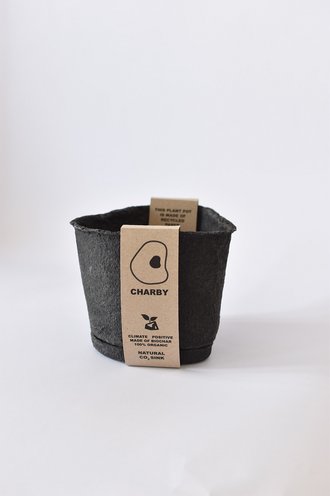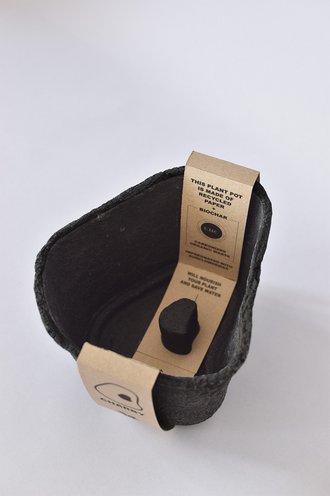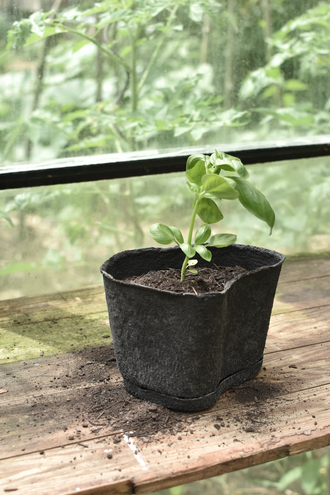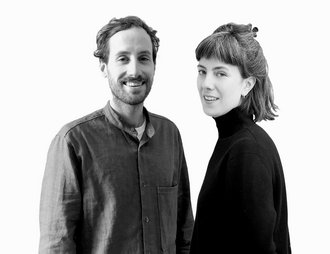Interdisciplinary Team of Students from the Bauhaus-Universität Weimar Wins German Design Council International Competition with Sustainable Plant Pot
Nora Giuliana Iannone, a Master’s student of architecture, and Massimo Scheidegger, a student from the Bachelor’s programme in Produktdesign, are among the winners of the international »ein&zwanzig« competition with their project »Future Artifact – Charby«. Their design for a planter made of vegetable carbon that binds CO2 is thus one of the total of 21 designs that have been invited to exhibit at the renowned design fair »Salone del Mobile« taking place in Milan from 6 to 12 June 2022.
What is vegetable or organic carbon? How can carbon bind CO2 when it is produced through combustion? And how can a plant container store CO2? To understand the idea behind »Future Artifact – Charby«, a tree’s life cycle must be considered. A tree can bind up to 10 kilograms of carbon dioxide per year – and this adds up over time. If this tree is cut down or has to be felled, the wood is used, burned or composted in a number of different ways. Emissions are usually produced when the bound CO2 is released.
This is where the concept of the »Future Artifact« project comes in; pyrolysis can be used to carbonise the ›excess‹ biomass without causing any CO2 emissions. Energy is supplied once as heat in a kind of kiln in which the organic material burns without oxygen. What remains is the so-called »vegetable or organic carbon« in which the CO2 stored by the tree remains permanently contained for up to 1,000 years. The heat supplied can in turn be recycled or used as district heat – a process that generates virtually no emissions. This production process not only corresponds to a net-zero technology, but is also climate positive as it binds more CO2 than it emits.
The students came upon the raw material during their research in the field of agriculture. »The indigenous people of the Amazon region were already familiar with this raw material’s favourable properties,« Scheidegger explains. »If the carbon is mixed into the soil, the latter’s properties improve tremendously. It can absorb and store far more water, which helps to reduce the leaching of nutrients and prevent erosion. Theoretically, it can be produced from any organic biomass.«
»We were excited about vegetable carbon’s ability to absorb CO2, hence we turned our attention to how this material can be used in other areas,« Iannone says of the project’s evolution. »We ultimately came up with the idea of being able to add and process pulverised vegetable carbon by means of fibre casting – this is how egg boxes are produced, for example. ›Charby‹ is merely a suggestion, an idea of how many different ways we can use this sustainable material. A planter the size of our prototype stores about one hundred times the CO2 mass of its capacity.«
Iannone and Scheidegger use their design as an example to demonstrate a possible usage scenario: the vegetable carbon they use is manufactured by a regional producer from the husks of sunflower seeds. Sunflower wax is also extracted from the leftover husks and used to seal the planter. This in turn enhances the water retention properties of the sustainable »flower pot«. At the end of its life cycle, the container can be shredded and spread in the garden to improve the soil.
The two students from the Bauhaus-Universität Weimar impressed the jury of the »ein&zwanzig« competition with their design. A »Best of Best« winner will be selected from the 21 winning works during the »Tortona Design Week« in Milan as the ultimate competition award. The award ceremony will take place in Milan on 6 June 2022.
The project »Future Artifact – Charby« was supervised by Gerrit Babtist, Professor of Design and Management, and the professorship’s artistic assistant, Sarah Böttger.
About the Competition
With the »one&twenty« competition, the German Design Council strives to give young designers the opportunity to exhibit their prototypes in Milan as part of the »Tortona Design Week 2022«. A total of 21 works have been selected and will now be presented during the »Salone del Mobile« design fair. The international competition is aimed at design students and alumni who are creating innovative and trend-setting work in the fields of furniture, home accessories, lighting, floor coverings, wallpaper, textiles and lifestyle.
About the German Design Council
The German Design Council has been operating as one of the world’s leading centres of expertise in communication and knowledge transfer within design, branding and innovation since 1953. With its international offers, support for young designers and memberships, it is part of the global design community and helps to foster networking and a global exchange. The German Design Council connects its members with countless other international design and branding experts, fosters discourse and provides important stimulus for the global economy. More than 350 companies currently count among its members.
Visit the competition website: www.ein-und-zwanzig.de/preistraeger/future-artifact-charby
In case of questions, please contact Romy Weinhold, Press and Public Relations Officer for the Faculty of Art and Design, via telephone (+49 (0) 36 43 / 58 11 86) or e-mail (romy.weinhold[at]uni-weimar.de).




